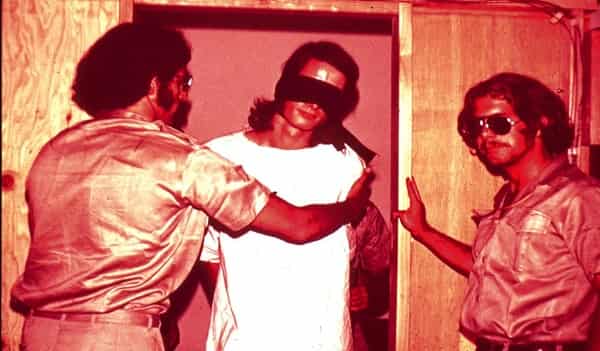Stanford Prison Experiment: Zimbardo’s Famous Study in Simple Words

In August 1971, psychologist Philip Zimbardo and his team conducted a famous study called the Stanford Prison Experiment. It aimed to explore how being a prisoner or a prison guard affects human behavior. Over the years, this experiment has become one of the most talked-about studies in psychology, though it remains highly controversial.
You might have read about it in textbooks, seen it mentioned in psychology classes, or even watched movies based on it. Here, we will explain what happened during the study, what researchers learned, and why many people have criticized it.
Why Was the Stanford Prison Experiment Conducted?
Zimbardo, a psychologist and former classmate of Stanley Milgram, wanted to expand on Milgram’s research about obedience to authority. Zimbardo focused on how situational factors—like being in a prison—can influence human behavior.
The main question was: How would healthy, normal people behave if placed in a prison-like environment? The researchers wanted to see if participants, knowing it was just an experiment, would still change their behavior in such a setting.
Who Participated in the Experiment?
To set up the study, the researchers built a fake prison in the basement of Stanford University’s psychology building. They recruited 24 college students to act as either prisoners or guards. These students were picked from a group of 70 volunteers based on several criteria: they had no criminal history, no mental health issues, and no significant medical problems. Each participant agreed to stay in the study for one to two weeks and was paid $15 a day.
How the Experiment Worked
The mock prison had three small cells, each six feet by nine feet, with three cots in each cell for the prisoners. The researchers also set up rooms for the guards and the warden. There was even a tiny room for solitary confinement and a small area designated as the “prison yard.”
Participants were randomly assigned to be either prisoners or guards. Prisoners had to stay in the fake prison 24 hours a day, while guards worked in shifts of eight hours each. When not on duty, guards were allowed to go home.
The researchers watched everything using hidden cameras and microphones to observe how people acted in this simulated prison environment.
What Happened During the Experiment?
Although the study was supposed to last 14 days, it was cut short after just six days because of how extreme things became.
Here’s what happened:
– Guards quickly became abusive, treating prisoners harshly and unfairly.
– Prisoners started showing signs of severe stress, anxiety, and helplessness. Many became passive and emotionally distressed.
– Five prisoners had such intense emotional reactions—like crying and panic—that they had to leave the study early.
The interactions between guards and prisoners turned hostile and dehumanizing. Guards became increasingly aggressive, while prisoners grew more submissive. Even the researchers lost perspective, as Zimbardo, who acted as the prison warden, failed to stop the abusive behavior. The experiment only ended after Christina Maslach, a graduate student, strongly objected to the inhumane conditions and ethical problems she observed.
Why Did People Act This Way?
One explanation for the participants’ behavior is a concept called deindividuation. This means that when people are part of a group, they may act in ways they wouldn’t normally behave as individuals. In the experiment, the roles of “guard” and “prisoner” seemed to strip participants of their usual sense of self, leading them to act in extreme ways.
Why Is the Experiment Important?
The Stanford Prison Experiment became a significant study in psychology. According to Zimbardo, it showed how much power a situation can have over a person’s actions.
For example:
– The guards, given authority and control, acted in ways they likely wouldn’t in their normal lives.
– The prisoners, placed in a powerless position, became withdrawn and depressed.
In 2011, the Stanford Alumni Magazine looked back at the experiment on its 40th anniversary. Interviews with participants, researchers, and Zimbardo himself reflected on how the study demonstrated the influence of roles and social expectations on behavior.
The experiment’s story even inspired a 2015 movie, *The Stanford Prison Experiment*, which dramatized the events of the study.
Criticisms of the Stanford Prison Experiment
Over the years, many people have criticized the study for several reasons. Here are the main points:
1. Ethical Issues
The experiment is often cited as an example of unethical research. Today, it would not be allowed under the ethical guidelines of organizations like the American Psychological Association.
Why was it unethical?
– Participants did not fully understand what they were signing up for (lack of informed consent).
– Some experienced psychological harm due to the abusive conditions.
– Researchers did not provide proper debriefings to help participants process their experiences.
– Evidence suggests the researchers may have encouraged abusive behavior from the guards.
2. Lack of Generalizability
The participants were mostly white, middle-class male college students. Because the group was not diverse, it’s hard to apply the findings to a wider population.
3. Lack of Realism
Critics argue that the experiment didn’t fully replicate real-life prison conditions. For example, participants knew they could leave the study at any time, which isn’t the case in actual prisons. This lack of realism may have influenced how participants behaved.
4. More Recent Criticisms
In recent years, researchers have found additional flaws in the experiment. For example:
– Some participants admitted to faking their behavior. One prisoner said he pretended to have a breakdown so he could leave the study.
– Others claimed they acted in ways they thought the researchers wanted them to.
– Evidence suggests the guards’ abusive behavior was encouraged by the experimenters, making the results less reliable.
In 2019, an article in the journal *American Psychologist* called the Stanford Prison Experiment “an incredibly flawed study that should have died an early death.” The article pointed out problems with the research design, procedures, and findings.
What Does Zimbardo Say About the Criticisms?
Zimbardo has defended the study’s main conclusion: that situational forces can strongly influence human behavior. However, the criticisms have significantly damaged the experiment’s scientific credibility.
What Can We Learn From This?
The Stanford Prison Experiment remains a well-known example of how roles and environments can shape behavior. While it has been widely criticized for ethical and methodological flaws, it continues to spark discussions about human nature, the impact of authority, and the importance of ethical standards in research.
FAQ: Stanford Prison Experiment
What was the Stanford Prison Experiment?
The Stanford Prison Experiment was a psychological study conducted in 1971 by Philip Zimbardo to explore how people behave in a prison-like setting. It simulated a prison environment, assigning participants to the roles of prisoners or guards.
Why did Zimbardo conduct this study?
Zimbardo wanted to investigate how situational factors and social roles affect human behavior. He aimed to understand if ordinary people would act differently in a simulated prison environment.
Who participated in the experiment?
The experiment involved 24 male college students selected from a larger group of 70 volunteers. They were screened to ensure they had no criminal background, psychological issues, or major medical conditions.
How was the experiment set up?
A fake prison was built in the basement of Stanford University’s psychology department. Participants were randomly assigned roles as either guards or prisoners, with prisoners staying in the “prison” 24/7 and guards working in eight-hour shifts.
What happened during the study?
The experiment quickly escalated:
– Guards became abusive and authoritative.
– Prisoners showed signs of extreme stress and anxiety.
– The study, planned to last 14 days, was halted after just six due to the negative psychological effects on participants.
Why is the Stanford Prison Experiment criticized?
The study faces criticism for multiple reasons:
1. Ethical Issues: Participants experienced harm, lacked fully informed consent, and were subjected to abusive conditions.
2. Lack of Realism: The simulated environment didn’t fully replicate real prison conditions.
3. Unreliable Results: Participants admitted to faking behaviors or acting as they thought researchers expected.
4. Researcher Influence: Evidence suggests Zimbardo and his team encouraged certain behaviors.
Could this experiment be conducted today?
No, it violates modern ethical guidelines for psychological research. Current standards require informed consent, protection from harm, and rigorous ethical oversight.
What did the experiment reveal about human behavior?
The study suggested that situational factors and assigned roles can significantly influence behavior. People placed in positions of power (guards) may act abusively, while those in powerless roles (prisoners) may become submissive.
Was the experiment’s conclusion valid?
While the experiment highlighted the potential impact of social roles, its scientific credibility has been heavily questioned due to ethical and methodological flaws. Critics argue that the results may not be reliable or generalizable.
What impact has the experiment had on psychology?
Despite its flaws, the Stanford Prison Experiment remains a widely discussed study in psychology, sparking debates about ethics, authority, and the role of environments in shaping behavior.
Are there any films about the Stanford Prison Experiment?
Yes, the 2015 film *The Stanford Prison Experiment* dramatizes the events of the study, offering a glimpse into what occurred.
What lessons can be learned from this experiment?
The study emphasizes the importance of ethical standards in research and serves as a reminder of how environments and roles can influence human behavior, both positively and negatively.
